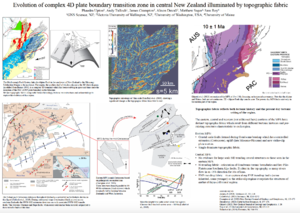2021 CSDMS meeting-078: Difference between revisions
From CSDMS
No edit summary |
No edit summary |
||
| (6 intermediate revisions by 2 users not shown) | |||
| Line 20: | Line 20: | ||
}} | }} | ||
{{CSDMS meeting abstract title temp2021 | {{CSDMS meeting abstract title temp2021 | ||
|CSDMS meeting abstract title=Evolution of complex 4D plate boundary transition zone in central New Zealand illuminated by its topographic fabric | |||
|Working_group_member_WG_FRG=Terrestrial Working Group, Geodynamics Focus Research Group | |Working_group_member_WG_FRG=Terrestrial Working Group, Geodynamics Focus Research Group | ||
}} | }} | ||
{{CSDMS meeting authors template | {{CSDMS meeting authors template | ||
|CSDMS meeting coauthor first name abstract= | |CSDMS meeting coauthor first name abstract=James | ||
|CSDMS meeting coauthor last name abstract= | |CSDMS meeting coauthor last name abstract=Crampton | ||
|CSDMS meeting coauthor | |CSDMS meeting coauthor country=New Zealand | ||
|CSDMS meeting coauthor | }} | ||
|CSDMS meeting coauthor country= | {{CSDMS meeting authors template | ||
| | |CSDMS meeting coauthor first name abstract=Andy | ||
|CSDMS meeting coauthor | |CSDMS meeting coauthor last name abstract=Tulloch | ||
|CSDMS meeting coauthor country=New Zealand | |||
}} | |||
{{CSDMS meeting authors template | |||
|CSDMS meeting coauthor first name abstract=Matthew | |||
|CSDMS meeting coauthor last name abstract=Sagar | |||
|CSDMS meeting coauthor country=New Zealand | |||
}} | }} | ||
{{CSDMS meeting authors template | {{CSDMS meeting authors template | ||
|CSDMS meeting coauthor first name abstract= | |CSDMS meeting coauthor first name abstract=Alison | ||
|CSDMS meeting coauthor last name abstract= | |CSDMS meeting coauthor last name abstract=Duvall | ||
|CSDMS meeting coauthor town-city=Seattle | |||
|CSDMS meeting coauthor town-city= | |||
|CSDMS meeting coauthor country=United States | |CSDMS meeting coauthor country=United States | ||
|State= | |State=Washington | ||
}} | |||
{{CSDMS meeting abstract template 2021 | |||
|CSDMS meeting abstract=The Marlborough Fault System (MFS) consists of four main dextral strike-slip faults which link subduction with oblique continental collision in central New Zealand. It is a zone where crustal transfer from one plate to another is occuring, where a subduction interface is developing within a previously intact plate and which varies along and across strike. We use a variety of tools including topographic fabric, river evolution, thermochronology and geological history to understand the deformation that is occurring across the MFS. We show that the eastern and western ends of these faults have had completely different evolutions through time. These apparently continuous strike-slip faults have coalised into through going structures quite recently. The signature of these processes can be found in the landscape. | |||
|CSDMS meeting posterPDF=Upton_etal_poster_2.pdf | |||
|CSDMS meeting posterPNG=Upton_etal_poster_2.png | |||
}} | }} | ||
{{blank line template}} | {{blank line template}} | ||
Latest revision as of 17:02, 13 May 2021
Log in (or create account for non-CSDMS members)
Forgot username? Search or email:CSDMSweb@colorado.edu
Browse abstracts
Evolution of complex 4D plate boundary transition zone in central New Zealand illuminated by its topographic fabric
Phaedra Upton, GNS Science Lower Hutt , New Zealand. p.upton@gns.cri.nz
James Crampton, , New Zealand.
Andy Tulloch, , New Zealand.
Matthew Sagar, , New Zealand.
Alison Duvall, Seattle Washington, United States.
The Marlborough Fault System (MFS) consists of four main dextral strike-slip faults which link subduction with oblique continental collision in central New Zealand. It is a zone where crustal transfer from one plate to another is occuring, where a subduction interface is developing within a previously intact plate and which varies along and across strike. We use a variety of tools including topographic fabric, river evolution, thermochronology and geological history to understand the deformation that is occurring across the MFS. We show that the eastern and western ends of these faults have had completely different evolutions through time. These apparently continuous strike-slip faults have coalised into through going structures quite recently. The signature of these processes can be found in the landscape.

